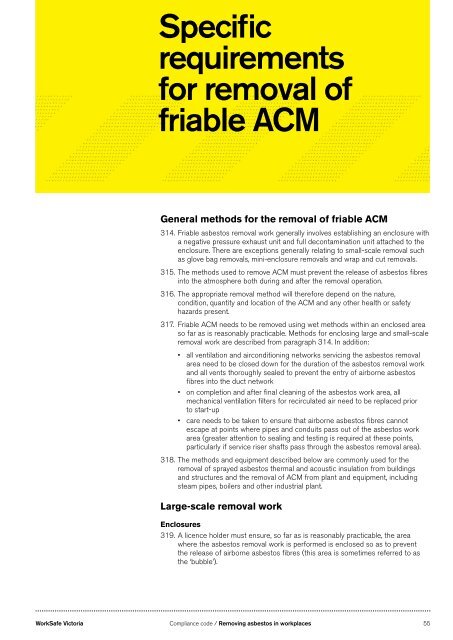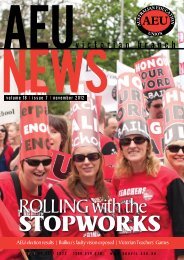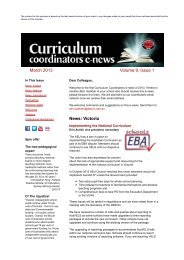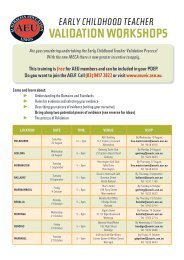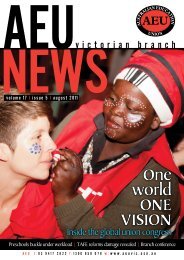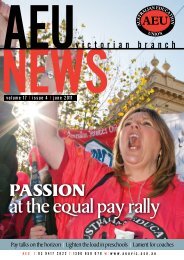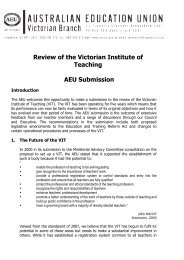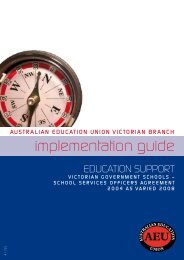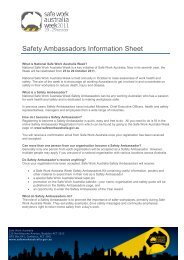Removing asbestos in workplaces - Compliance ... - WorkSafe Victoria
Removing asbestos in workplaces - Compliance ... - WorkSafe Victoria
Removing asbestos in workplaces - Compliance ... - WorkSafe Victoria
Create successful ePaper yourself
Turn your PDF publications into a flip-book with our unique Google optimized e-Paper software.
Specificrequirementsfor removal offriable ACMGeneral methods for the removal of friable ACM314. Friable <strong>asbestos</strong> removal work generally <strong>in</strong>volves establish<strong>in</strong>g an enclosure witha negative pressure exhaust unit and full decontam<strong>in</strong>ation unit attached to theenclosure. There are exceptions generally relat<strong>in</strong>g to small-scale removal suchas glove bag removals, m<strong>in</strong>i-enclosure removals and wrap and cut removals.315. The methods used to remove ACM must prevent the release of <strong>asbestos</strong> fibres<strong>in</strong>to the atmosphere both dur<strong>in</strong>g and after the removal operation.316. The appropriate removal method will therefore depend on the nature,condition, quantity and location of the ACM and any other health or safetyhazards present.317. Friable ACM needs to be removed us<strong>in</strong>g wet methods with<strong>in</strong> an enclosed areaso far as is reasonably practicable. Methods for enclos<strong>in</strong>g large and small-scaleremoval work are described from paragraph 314. In addition:• all ventilation and aircondition<strong>in</strong>g networks servic<strong>in</strong>g the <strong>asbestos</strong> removalarea need to be closed down for the duration of the <strong>asbestos</strong> removal workand all vents thoroughly sealed to prevent the entry of airborne <strong>asbestos</strong>fibres <strong>in</strong>to the duct network• on completion and after f<strong>in</strong>al clean<strong>in</strong>g of the <strong>asbestos</strong> work area, allmechanical ventilation filters for recirculated air need to be replaced priorto start-up• care needs to be taken to ensure that airborne <strong>asbestos</strong> fibres cannotescape at po<strong>in</strong>ts where pipes and conduits pass out of the <strong>asbestos</strong> workarea (greater attention to seal<strong>in</strong>g and test<strong>in</strong>g is required at these po<strong>in</strong>ts,particularly if service riser shafts pass through the <strong>asbestos</strong> removal area).318. The methods and equipment described below are commonly used for theremoval of sprayed <strong>asbestos</strong> thermal and acoustic <strong>in</strong>sulation from build<strong>in</strong>gsand structures and the removal of ACM from plant and equipment, <strong>in</strong>clud<strong>in</strong>gsteam pipes, boilers and other <strong>in</strong>dustrial plant.Large-scale removal workEnclosures319. A licence holder must ensure, so far as is reasonably practicable, the areawhere the <strong>asbestos</strong> removal work is performed is enclosed so as to preventthe release of airborne <strong>asbestos</strong> fibres (this area is sometimes referred to asthe ‘bubble’).<strong>WorkSafe</strong> <strong>Victoria</strong> <strong>Compliance</strong> code / <strong>Remov<strong>in</strong>g</strong> <strong>asbestos</strong> <strong>in</strong> <strong>workplaces</strong> 55


